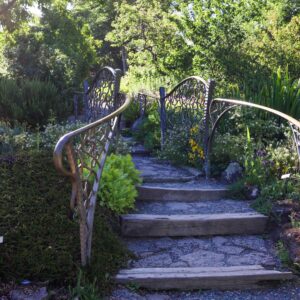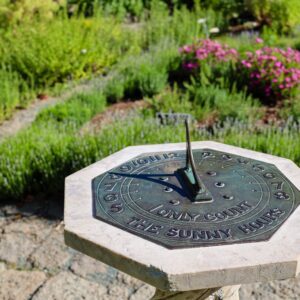 The Herb Garden began in the late 1940’s, the inspiration of volunteer Elizabeth Rollins, who designed and planted it. Since then, it has been a favorite of visitors who are delighted by the Garden’s classic beauty.
The Herb Garden began in the late 1940’s, the inspiration of volunteer Elizabeth Rollins, who designed and planted it. Since then, it has been a favorite of visitors who are delighted by the Garden’s classic beauty.
Throughout history herbs have been collected, cultivated, studied, and used by many different civilizations. European herb gardens have been particularly influenced by the medieval gardens of monastic communities. This Herb Garden displays traditionally inspired plantings surrounding the ornamental sundial and knot gardens, as well as sections divided according to the primary use of each herb. The collection features rare and unusual plants along with the familiar that provide food, flavorings, fragrances, teas, medicines, dyes, wine, beer, and liquors.
Here we use the term herb broadly to mean a useful plant. “Natural” herbs are not necessarily safe. Do not eat or taste any part of the plants in this garden.
Looking for a specific herb? Check our plant database.
The Herb Garden Bridge and Pond

by Stephen Woo
In 1994 artisan Michael Bondi and his team crafted the beautiful bronze and nickel bridge crossing a small pond in the Herb Garden. The hammer marks, texture and patina on the bridge are the marriage of fire, metal and creativity in Bondi’s forge. Bondi is a modern blacksmith who designs and crafts metalworks using traditional forging techniques at his Richmond foundry. Bondi explained, “The bridge was a wonderful opportunity to completely design and create a contemporary mixed metal piece. It’s about textures and movement. Cracked ice was the inspiration for the side panels.” Bondi’s architectural gates, stairs, and doors grace residences and commercial spaces all over the United States.
The bridge crosses a small pond fed by natural springs. Prior to 1994, when the bridge was built, visitors crossed the pond on stepping stones. At some times of the year the pond surface and stepping stones were completely obscured by duckweed (Lemna minor) and water fern (Azolla filiculoides). The bridge provides a safe and beautiful path across the pond.
When you visit, pause on the Herb Garden bridge for a view of one of Berkeley’s few remaining natural springs, brimming with aquatic plants. Listen for the chirrup of the tiny Pacific chorus frogs who thrive in the pond and throughout the moist areas of the Garden.
The Herb Garden Sundial

by Stephen Woo
This sundial was carefully placed many years ago (circa 1950) to accurately indicate standard time, not Daylight Savings Time. Sundial design and placement is the union of mathematics, science and art and is becoming a lost skill. Traditionally placed in gardens, a sundial connects the garden (and gardener) intimately with the sun, shadows and seasons, and like the Garden’s, may convey advice for a content life. The dial reads, I Only Count The Sunny Hours.

